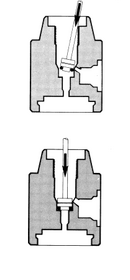I had an upstream regulator (a Poseidon "Odin") fail at about twenty meters, years ago -- a single time -- back when we would send out our equipment, for servicing in batches. The overpressure valves, then located on the hoses themselves, did their job; vented excess gas; and allowed for a loud though safe ascent.
It was due, we later determined, to an o-ring failure at the HP seat. When properly installed on a drift (see below), that seat (on the 2960s) was initially inserted at an angle, to avoid any direct o-ring contact with the knife edge of the HP bore.
When that first stage was disassembled, that grease-encapsulated o-ring (back then, they larded everything up, but good) had been nearly severed.
That shop, now long gone, simply gave us a few spare o-rings, though no apology whatsoever; and were further ticked, that we demanded back our other gear, then set for repair.
Two takeaways -- upstream regulators are indeed safe and will continue to deliver air upon a first stage failure, regardless of popular myth; and, secondly and more relevantly, we began to perform all of our subsequent overhauls, in-house, without further incident . . .






